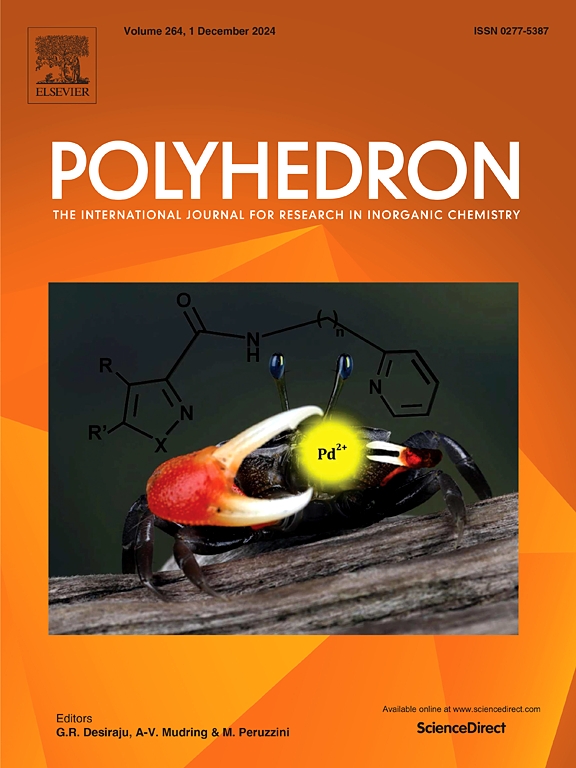Advances in photo-electrocatalytic materials for environmental protection: Application to water and wastewater treatment
IF 2.4
3区 化学
Q2 CHEMISTRY, INORGANIC & NUCLEAR
引用次数: 0
Abstract
This work explores the elimination of Rhodamine B (Rh B) via electrocatalytic and electro-photocatalytic processes, employing Ba2SnO4 double perovskite as the anodic material. Ba2SnO4 was synthesized via hydrothermal method and comprehensively characterized using structural, optical, and electrochemical techniques to evaluate its potential for Rhodamine B oxidation. X-ray diffraction confirmed the formation of a single-phase tetragonal structure (space group I4/mmm), with spherical particles approximately 50 nm in diameter. Dynamic light scattering (DLS) indicated an average particle size of 0.35 µm, and zeta potential measurements showed a surface charge of −5 mV. Scanning electron microscopy revealed a porous surface texture. Optical characterization via diffuse reflectance spectroscopy identified a direct bandgap of 3.23 eV, attributed to O2− (2p) to Sn4+ (5 s) charge transfer. The material demonstrated high chemical resilience across a wide pH range. Mott-Schottky analysis confirmed its n-type semiconducting nature, likely due to oxygen vacancies. The observed low electron mobility was linked to the narrow conduction band formed by Sn4+: 5 s states, with an activation energy of 18 meV, indicative of small polaron hopping as the dominant transport mechanism. The current density–voltage (J–E) curve in NaCl (10−2 M) displayed minimal hysteresis, characteristic of a chemically stable system akin to a chemical diode. In electrocatalytic tests, ∼65% of Rh B was degraded under a direct current of 150 mA, showcasing antibacterial effects. This performance was significantly enhanced under combined electro-photocatalytic conditions, reaching ∼95% degradation under simultaneous exposure to sunlight and electrical bias.
环保光电催化材料的研究进展:在水和废水处理中的应用
本研究以Ba2SnO4双钙钛矿为阳极材料,通过电催化和光电催化工艺探讨了罗丹明B (Rh B)的去除。采用水热法合成了Ba2SnO4,并利用结构、光学和电化学技术对其进行了综合表征,以评价其氧化罗丹明B的潜力。x射线衍射证实形成了一个单相四方结构(空间群I4/mmm),其球形颗粒直径约为50 nm。动态光散射(DLS)结果表明,该材料的平均粒径为0.35µm, zeta电位测量结果表明其表面电荷为−5 mV。扫描电子显微镜显示了多孔的表面结构。通过漫反射光谱的光学表征发现了3.23 eV的直接带隙,归因于O2−(2p)到Sn4+ (5 s)的电荷转移。该材料在很宽的pH范围内表现出很高的化学弹性。莫特-肖特基分析证实了它的n型半导体性质,可能是由于氧空位。观察到的低电子迁移率与Sn4+: 5 s态形成的窄传导带有关,活化能为18 meV,表明小极化子跳变是主要的输运机制。在NaCl(10−2 M)中,电流密度-电压(J-E)曲线显示出最小的滞后,具有类似于化学二极管的化学稳定系统的特征。在电催化试验中,约65%的Rh B在150 mA的直流电流下被降解,显示出抗菌效果。在联合光电催化条件下,这种性能显著增强,在同时暴露于阳光和电偏压下达到~ 95%的降解。
本文章由计算机程序翻译,如有差异,请以英文原文为准。
求助全文
约1分钟内获得全文
求助全文
来源期刊

Polyhedron
化学-晶体学
CiteScore
4.90
自引率
7.70%
发文量
515
审稿时长
2 months
期刊介绍:
Polyhedron publishes original, fundamental, experimental and theoretical work of the highest quality in all the major areas of inorganic chemistry. This includes synthetic chemistry, coordination chemistry, organometallic chemistry, bioinorganic chemistry, and solid-state and materials chemistry.
Papers should be significant pieces of work, and all new compounds must be appropriately characterized. The inclusion of single-crystal X-ray structural data is strongly encouraged, but papers reporting only the X-ray structure determination of a single compound will usually not be considered. Papers on solid-state or materials chemistry will be expected to have a significant molecular chemistry component (such as the synthesis and characterization of the molecular precursors and/or a systematic study of the use of different precursors or reaction conditions) or demonstrate a cutting-edge application (for example inorganic materials for energy applications). Papers dealing only with stability constants are not considered.
 求助内容:
求助内容: 应助结果提醒方式:
应助结果提醒方式:


